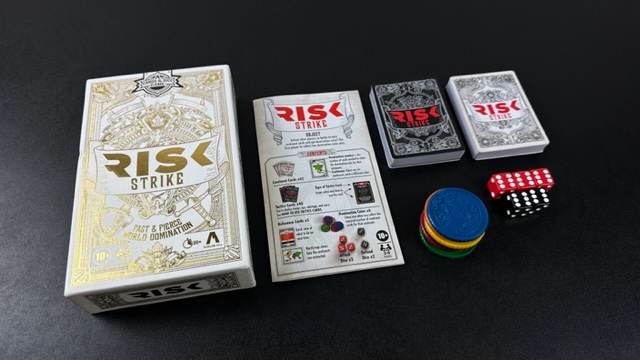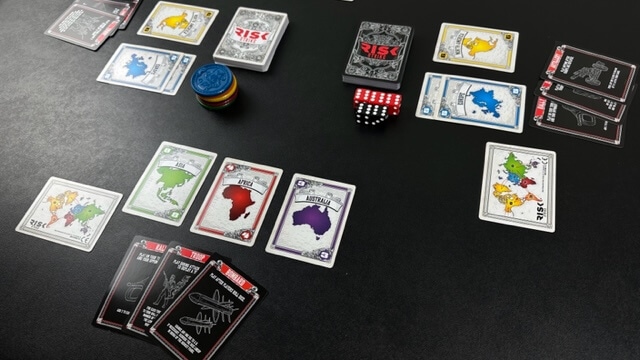
OBJECTIVE: The first player to earn two domination coins wins the game
NUMBER OF PLAYERS: 2 – 5 players
MATERIALS: 42 continent cards, 40 tactics cards, 5 reference cards, 6 domination coins, 3 attack dice, 2 defend dice
TYPE OF GAME: Card and dice strategy game
AUDIENCE: Ages 10+
OVERVIEW OF RISK STRIKE

Risk Strike is a card and dice version of the classic game, Risk. Players are racing to be the first to conquer two entire continents. Rather than move pieces across a board, players will collect sets of continent cards and play them to the table much like in rummy. Battles are declared, tactics cards are deployed, and dice are rolled to resolve combat.
WHAT’S IN THE BOX

Each card in the continent deck contains a domination number. This number determines how many copies of that continent a player must have in order to consider it conquered. The forty tactics cards are used for attacking, defending, and disrupting battle. Five reference cards help players remember what to do on their turn as well as display the connections between continents. Six domination coins, one for each continent, are collected once that particular continent is conquered by a player. Like in classic Risk, there are three red attack dice, and two black defend dice.
SETUP OF RISK STRIKE

Shuffle the white continent cards and the black tactics cards separately. Deal three white continent cards to each player. Those three cards are placed face up in front of them on the table. Next, deal three black tactics cards to each player (which forms their hand). Do not let opponents see your tactics cards.
Give each player a reference card. Put the domination coins and dice in the center of the table.
Every player rolls a single die. The person who rolls the highest number gets to go first. All the other players draw an additional tactics card (this excludes the person who goes first). In a two player game, the person who is not going first draws an additional continent card as well.
Finally, there needs to be space in the center of the table for a surrendered continent card display.
THE PLAY OF RISK STRIKE
A player’s turn begins by drawing two cards. These two cards can include: two continent cards, two tactics cards, or one continent and one tactics card. Tactics cards are added to the hand, and continent cards are placed face up in front of the player.
After drawing, a player may attack or pass.
PASS
If a player chooses to pass, they draw an additional tactics card and end their turn.
ATTACK
A player may only attack once per turn, and attacking consists of three phases.
Players may only attack within the same continent or a continent that is connected. To begin the attack, a player declares who their opponent is, the continent they are attacking from, as well as which continent they are attacking. Refer to the map on the reference card for continent connections.
Step two of the attack consists of troop deployment. Launch the attack by playing any number of troop tactics cards from the hand. Attacking troop cards are placed face up next to the continent from which they are attacking. The defending player then deploys their troop cards and places them next to the continent from which they are defending. After the attacker and defender have deployed their troop cards, other players may deploy troops to aid the attacker or the defender. Which player they are defending must be announced immediately.
Step three is to roll dice and resolve the battle. Both the attacker and defender count up the continent cards and troop cards they have involved in the battle. This number determines how many dice they get to roll. The attacker can only roll a maximum of three dice, and the defender can only roll a maximum of two dice. After rolling, each player lines up their dice to compare.
Dice are compared in order from highest to lowest, so the attacker’s highest die is compared to the defender’s highest die and so on. With an attack die that is higher, the defender must discard an active troop card (one that they played from their hand). If they do not have any troop cards played, they must surrender a continent card that is being attacked by giving it to the attacker. A defender wins if their die is equal to or greater than the attacking die, and the attacker must discard a troop card or surrender a continent card from which they are attacking and place it in the surrendered continent card pile (in the center of the table). Once the highest dice are compared, move on to the next pair of dice and continue the process.
An attack may be continued if there are still attacking continent cards AND defending continent cards remaining. Otherwise, the attack ends, and any remaining troop cards are discarded. If the attacking player chooses to continue their attack, both players roll their dice again. The battle is resolved, and the attack phase continues until the attacker chooses to stop or there are no longer continent cards to allow the attack.
Play passes left once the turn is over.
TACTICS CARDS
Eight different types of tactics cards provide a variety of strategies. Each card describes when they can be used. A player can play as many tactics cards from their hand as they want. There is no limit. Tactics cards are resolved in the order they are played. Once a tactics card is resolved, it is discarded.
The troop cards are used in battle, and they give the player more dice to use while attacking or defending. Spy cards can be played any time during your turn, and they allow you to look at one player’s cards. Also, you draw one tactics card from the deck. Canceled orders cards allow you to cancel a tactics card played by an opponent. Troop cards cannot be canceled. Rally cards are played after you roll dice during a battle. Add two to each of your dice. Artillery can be played any time after troops are deployed, and they force one player (of your choice) to discard up to two active troop cards. Sabotage cards must be played immediately after troops are deployed and the battle ends. Any troop cards are returned to the player’s hand and the turn ends. Expand cards can be played any time during your turn, and you can draw either two continent cards or one tactics card. Bombard cards are played after players roll their dice. Change any one die to a 6 and reorder the pairs for resolving the attack.
DOMINATING
As soon as you have captured a number of continent cards equal to or greater than the domination number on the card, take that continent’s domination coin (either from the coin pile or from another player). Once you have that coin, you cannot lose it until an opponent meets the domination requirement for that continent and takes it from you. Even if you lose enough continent cards to bring your total below the domination number for that continent, you still keep the coin.
WINNING RISK STRIKE
The first player to collect two domination coins wins the game.
- TRIPLE SNAKES - February 15, 2021